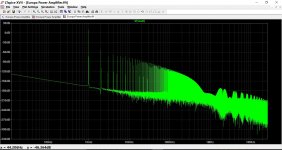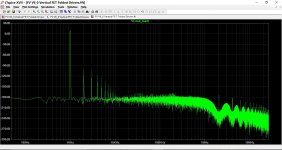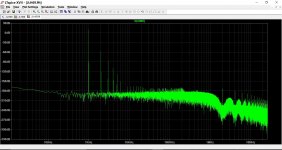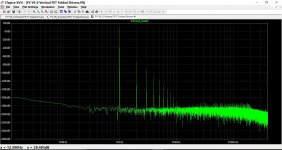I listened to all 3 files several times thru on headphones. There is one I don't like, but the other two are similar. Not having the original files, I can't compare to non processed. Maybe the one I don't like actually sound more like the original file. 
Can I vote for least favorite?
Can I vote for least favorite?
Have you given them a listen ?

I just downloaded and listened thru windows media player.
One clip is very fatiguing. Correlating the sound with fft, this must be the europa.
One clip is not fatiguing but lack of definition due to its distortion. But its a low order distortion. Correlating the sound with fft, this must be jlh.
One clip is not fatiguing, has best definition. Correlating the sound with fft, this must be the fet amp.
Two things are confusing tho. First, why the reference has more distortion than the last clip. Second, the fft of the fet amp is too good to be true. Its my favorit but i think the fft shouldnt be that good. Or may be theres uggly fft past 200khz not shown in your screenshot.
Thanks.
I voted. Interesting to see the results.
Since Foobar was not working for some reason, I could not do the ABX test. Really wanted to.
That's a shame
I just downloaded and listened thru windows media player.
One clip is very fatiguing. Correlating the sound with fft, this must be the europa.
One clip is not fatiguing but lack of definition due to its distortion. But its a low order distortion. Correlating the sound with fft, this must be jlh.
One clip is not fatiguing, has best definition. Correlating the sound with fft, this must be the fet amp.
Two things are confusing tho. First, why the reference has more distortion than the last clip. Second, the fft of the fet amp is too good to be true. Its my favorit but i think the fft shouldnt be that good. Or may be theres uggly fft past 200khz not shown in your screenshot.
Thanks.
Thanks for giving them a listen.
Here are more extended FFT's for the three amps stretching out to 10MHz.
Your subjective listening comments are interesting as we often find that listeners prefer certain amps and topologies, or perhaps even valve amps that would measure poorly in other aspects such as damping and so on.
Is it possible that some amplifiers 'gloss over' some audible artefacts in the original material and present us with a listening experience we prefer.
That seems to happen in real life, it would be fascinating if the same were happening in the simulations.
Attachments
Here are more extended FFT's for the three amps stretching out to 10MHz.
Funny thing is that your FET amp's fft is very similar to the JLH. But I guess it is because of the windowing chosen (which I'm not familiar with).
Your subjective listening comments are interesting as we often find that listeners prefer certain amps and topologies, or perhaps even valve amps that would measure poorly in other aspects such as damping and so on.
Human's ears are very sensitive to low frequency, and they are very fond of the bass too. If you have ever wondered why someone rave about certain amp that you think is ordinary, most of the time (often indirectly) it is because of the bass 'quality'. Often inaccurate bass quality is more preferred than the accurate one.
Is it possible that some amplifiers 'gloss over' some audible artefacts in the original material and present us with a listening experience we prefer.
By removing the HF components (rolling off the response), sibilance and fatigue may be reduced. Second order may mask higher order distortions to some degrees. Then there is the "effect box" thing where we just add something not in the source.
That seems to happen in real life, it would be fascinating if the same were happening in the simulations.
Most of it happens in simulation (the variables required are mostly modeled).
The FET amp has a distortion profile that is alterable (R24 on the diagram). This shows it set up to make it more like the JLH.
Having listened again closely to the files, and also comparing to the original master file I would have to say that the results seem in line with what you might expect.
Its fascinating stuff and I wish more would listen and give an opinion.
You mention bass quality. My own amp (not these under test here) has an added 0.22 ohm series resistance in the speaker feed.
Having listened again closely to the files, and also comparing to the original master file I would have to say that the results seem in line with what you might expect.
Its fascinating stuff and I wish more would listen and give an opinion.
You mention bass quality. My own amp (not these under test here) has an added 0.22 ohm series resistance in the speaker feed.
Attachments
Odd choice of song. Sounds like a lot of distortion on the vocal, and on the whole mix in the chorus, such as can be clearly heard during the brief interlude from around 0:47 to 0:51 where there is a break in the vocals. Cymbals sound like noise there.
Guess the vocals sounded better with the distortion than without, and maybe they decided to give the whole song (album?) some of that "flavor."
Seems like an odd choice, because its harder to judge distortion from amp models where there is preexisting distortion on a song.
Last edited:
Mark, Mark Mark. What can I say. Previous listening tests have included Bach, Beethoven, Moody Blues, Genesis, Supertramp.... the list goes on, and there are always complaints  but nonetheless I thank you for listening.
but nonetheless I thank you for listening.
Choice of material crops up every time.
Have you listened to the 'amps' and compared them in turn to the original ? There are audible differences and one does sound more different than the other two imo.
Choice of material crops up every time.
Have you listened to the 'amps' and compared them in turn to the original ? There are audible differences and one does sound more different than the other two imo.
I haven't listened yet. I'm a little dubious about listening to models.
There have been many attempts at digital physical modeling of hardware boxes. I haven't heard one yet that sounds like the real thing.
I think you could counter that by saying that we seem happy enough looking at the simulated results of the models in our circuits, and we happily refine our designs based on that.
Some of the intrinsic properties of the circuit surely must come across in the simulated version. Those differing distortion profiles have to be reflected in the audio in the files.
Your second point is very valid and all manner of effects can come into play in the real build. PSU interactions, physical layout and crosstalk are three that come to mind.
At first I was under impression that the amps 2 and 3 sounded somewhat better than 1 and then I abx-ed myself between 1-2, 2-3, and 1-3, with a score from 60-90% of probability that I was guessing. Listened through the headphones and a cheap laptop.
Like Lojzek I also thought 2&3 sounded better than amp 1, which was muddy and bass heavy to my ears. But since Foobar refused to work for me, I could not put that to a real ABX test. I might have scored as badly.
Thanks for giving these a listen guys. Just vote on which you would most prefer to live with
I think you could counter that by saying that we seem happy enough looking at the simulated results of the models in our circuits, and we happily refine our designs based on that.
Some of the intrinsic properties of the circuit surely must come across in the simulated version. Those differing distortion profiles have to be reflected in the audio in the files.
Your second point is very valid and all manner of effects can come into play in the real build. PSU interactions, physical layout and crosstalk are three that come to mind.
Okay. I would suggest that most people seem to get more accurate simulation results if they upsample the wave file first, run it through the simulator, then downsample. If any distortion is added by the model, it may violate nyquist and produce aliasing. Upsampling usually at least helps. Depending on how high-order the amplifier model distortion is, of course.
That's perhaps something to look at should I try any more similar experiments.
This is the first time I've done anything like this, in fact I've never seen this kind of thing done before, and as such I have no worked examples to follow.
If any distortion were being added by the model, then would that not show in the normal sine type simulation ? This is getting into the old argument that music signals are in some way a more difficult test signal.
It might be worth running a .wav sine as a test signal and seeing if the result compares to the basic LT simulation.
This is the first time I've done anything like this, in fact I've never seen this kind of thing done before, and as such I have no worked examples to follow.
If any distortion were being added by the model, then would that not show in the normal sine type simulation ? This is getting into the old argument that music signals are in some way a more difficult test signal.
It might be worth running a .wav sine as a test signal and seeing if the result compares to the basic LT simulation.
Hi Mooly,
interesting thread. I was the first one that voted and came back often to see how it is doing.
Shame that you only had seven voters so far. You do mention in real life there are a lot more variables than just the amplifier design and harmonic distribution, but strangely this is where amp design begins and tweaks take place, the other issues are usually secondary.
Removing all the other added noises out of the experience in order the evaluate the design probably puts audiophiles in a predicament that they are not listening to equipment.
The file I voted for seems to be the current trend and I am eager to see if this remains so.
Come on guys give it a listen, there is no right or wrong vote.
interesting thread. I was the first one that voted and came back often to see how it is doing.
Shame that you only had seven voters so far. You do mention in real life there are a lot more variables than just the amplifier design and harmonic distribution, but strangely this is where amp design begins and tweaks take place, the other issues are usually secondary.
Removing all the other added noises out of the experience in order the evaluate the design probably puts audiophiles in a predicament that they are not listening to equipment.
The file I voted for seems to be the current trend and I am eager to see if this remains so.
Come on guys give it a listen, there is no right or wrong vote.
- Status
- This old topic is closed. If you want to reopen this topic, contact a moderator using the "Report Post" button.
- Home
- Member Areas
- The Lounge
- Welcome to the (virtual) listening room.
 have fun
have fun 


